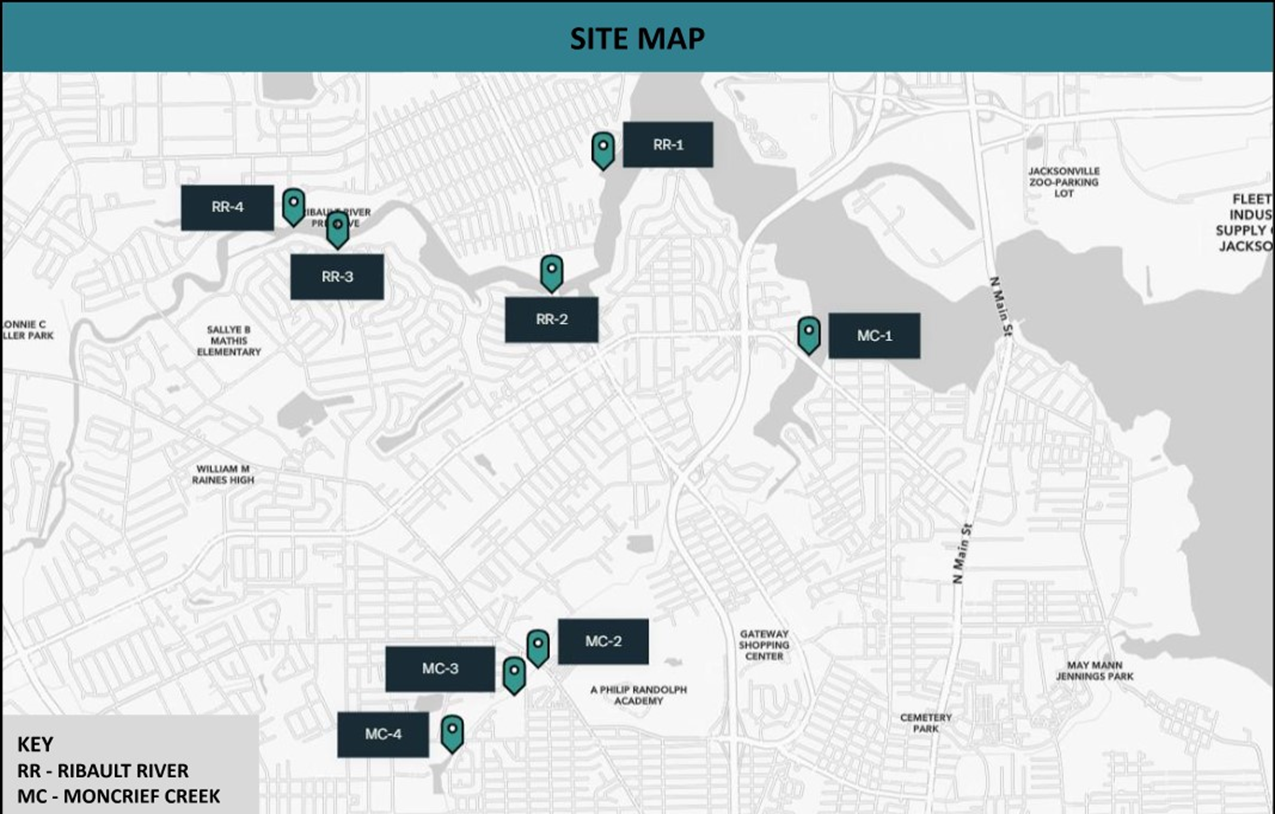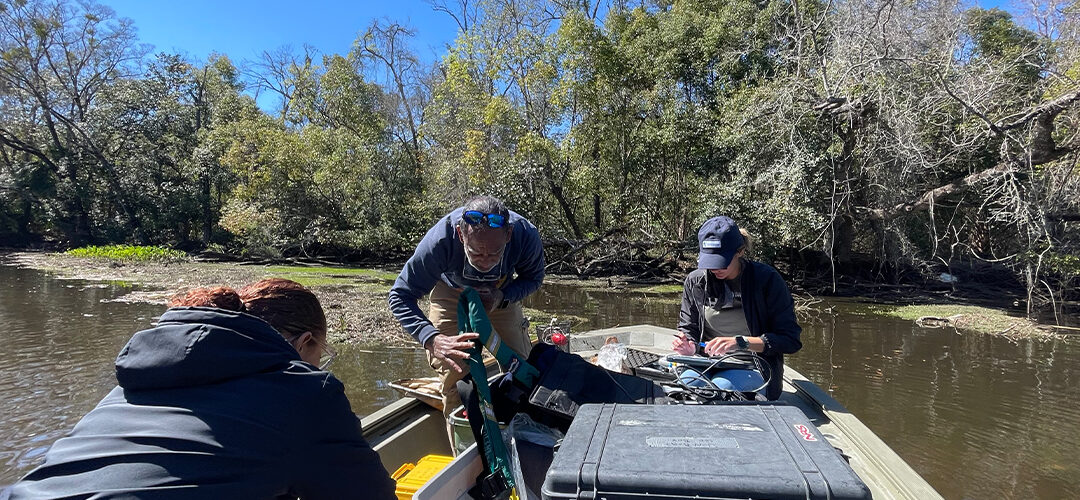Resilient Ribault
St. Johns Riverkeeper is intentionally focusing time and resources into the Ribault River, Trout River, and Moncrief Creek watersheds as part of the Resilient Ribault project in an effort to improve water quality, community health and neighborhood resilience. This is a pilot program that we plan to use to address other vulnerable tributaries and their watersheds in the future.
In partnership with scientists from Jacksonville University’s Marine Science Research Institute, we are conducting a two-year Environmental Quality Assessment of the Ribault River and Moncrief Creek watersheds to:
- Evaluate environmental and water quality problems,
- Identify sources of pollution,
- Implement solutions.
We are gathering valuable scientific data over time to find out where problems exist, pinpoint the best possible solutions, and ensure clean water for these communities.
St. Johns Riverkeeper recently received a generous grant from the City of Jacksonville’s Environmental Protection Board (EPB) that will allow us to continue and expand this important work.
What are we looking for?
 Both the Ribault River and Moncrief Creek are affected by multiple water quality challenges, with long-standing fecal coliform contamination being among the most significant. In response to this impairment, Moncrief Creek has been managed under a 2010 Basin Management Action Plan (BMAP), while the Ribault River has been under a 2014 Bacteria Pollution Control Plan (BPCP).
Both the Ribault River and Moncrief Creek are affected by multiple water quality challenges, with long-standing fecal coliform contamination being among the most significant. In response to this impairment, Moncrief Creek has been managed under a 2010 Basin Management Action Plan (BMAP), while the Ribault River has been under a 2014 Bacteria Pollution Control Plan (BPCP).
Although efforts such as septic tank phase-outs and stormwater infrastructure improvements are underway within the watershed, both waterways continue to experience persistently high levels of fecal indicator bacteria (FIB). To date, limited work has been done to determine the extent to which contamination sources are human-related or to assess the associated public health risks.
We are conducting monthly fecal bacteria sampling at eight sites, and will continue to do so for a total of two years. At sites with chronically high bacteria levels, a more intensive investigation will be conducted to identify the sources.
Due to several incinerator ash sites located along the Ribault and Moncrief, water, sediment, and macroinvertebrate samples are tested for heavy metals and toxic substances found in the ash.
Another significant concern for both waterways is nutrient impairment. The Ribault River is listed as impaired for nutrients based on elevated aquatic macrophyte indicator levels, while Moncrief Creek is impaired due to high concentrations of chlorophyll a. Excess nutrients, particularly nitrogen and phosphorus, can fuel the growth of harmful algal blooms, including toxic blue-green algae, which pose ecological and public health risks. A more comprehensive assessment is needed to determine whether the Ribault River and Moncrief Creek serve as sources of nutrient loading to the nutrient-impaired Trout River, which may in turn contribute to nutrient enrichment in the Lower St. Johns River.
To date, there has been limited systematic data collection aimed at understanding nutrient dynamics and identifying sources within the Ribault River and Moncrief Creek watersheds. As part of our monitoring efforts, we collect nutrient samples every other month.
We also conduct water quality testing, such as temperature, dissolved oxygen, salinity, pH, and turbidity at each site to assess current conditions, identify trends, and compare our findings over time.
The tests we are conducting are critical for assessing water quality, identifying potential sources of pollution, and understanding their impacts on aquatic habitats and public health. By examining patterns in bacterial contamination and nutrient concentrations over time, this assessment aims to provide actionable insights for improving environmental management strategies and protecting both the river’s ecosystem and our community’s well-being.
We also plan to test local fish for pollutants and metals, so we can better understand if fish caught in these tributaries are safe for consumption. This is a common concern from locals.
What are we finding so far?
Overview
We have 4 sites on the Ribault River and 4 sites on Moncrief Creek, spanning from the mouth to the freshwater sections.
- A couple of our sites are close to FDEP and/or COJ testing sites, and the rest fill in the gaps between those sites.
- All of our data is collected monthly, with the exception of nutrient data, which is collected every other month.
- In the below data overview, “above threshold” means levels are higher than the standard set by FDEP. Learn more here in the St. Johns River Report.
Since October 2024, we have conducted 9 field visits to the Ribault and 8 field visits to Moncrief Creek for the months of October 2024 through June 2025. We collected 170 FIB and 58 nutrient samples.
- 84 of the bacteria samples were above threshold values.
- 6 nutrient values have been above threshold.
 In-Depth Look
In-Depth Look
- 41 of the FIB samples that were above threshold values were in the Ribault.
- 43 of the FIB samples that were above threshold values were in Moncrief.
- 10 in the Ribault were E.Coli, 31 were Enterococci.
- 13 in Moncrief were E.Coli, 30 were Enterococci.
- 6 nutrient samples were above threshold values for these waterbodies:
- 1 for Total Nitrogen (TN) in the Ribault River
- 3 for Total Phosphorous (TP) in Ribault River
- 2 for Total Phosphorous (TP) in Moncrief Creek
- For values that exceeded the threshold, the majority did so only moderately, rather than by an exponential margin.
We extend our sincere gratitude to Jacksonville University’s Marine Science Research Institute, with special appreciation to Dr. Gerry Pinto, Dr. Gretchen Bielmyer-Fraser, Dr. Lucy Sonnenburg, Ceff Ramirez, and the graduate students involved in this project for their invaluable support. Their provision of research vessels and scientific expertise has been instrumental to the success of this work.
